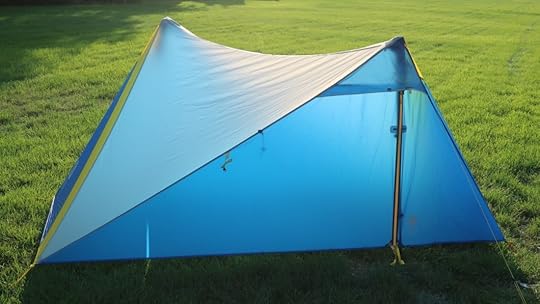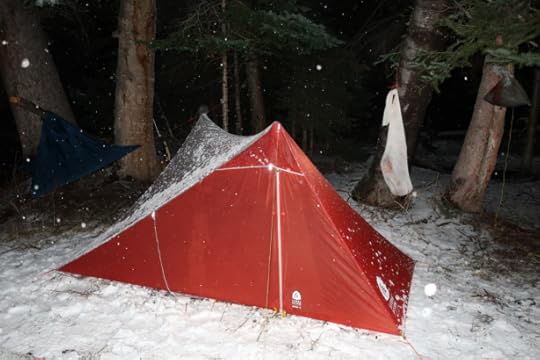Preview: Sierra Designs High Route 2.0 || Smaller, but now just 27 oz for fly + inner


The updated Sierra Designs High Route 1 will be smaller and 10 oz lighter than the original.
The Sierra Designs High Route 1FL was launched in fall 2016, and a second-generation will arrive in spring 2019. Its name will not change (i.e. not High Route 2.0 or High Route II), and the existing design will be phased out. MSRP remains $300.
Most notably, the updated High Route is smaller than the original. Instead of being an oversized one-person tent that can fit two, it’s now a true solo shelter.
Along with a few other tweaks, this downsizing translated to significant weight savings. The second-generation specs at just 1 lb 11 oz (27 oz; 765 grams) for the fly and inner, versus 2 lbs 5 oz for the original, a 10-oz reduction. More specifically, the fly is 16 oz and the inner body is 11 oz. These weights include guylines and tensioners.
The High Route requires a minimum of six stakes, and two more are included so that its doors can be porched open (+3.5-ish oz total). Stuff sacks add another ounce. SD is reporting the packaged weight, which includes everything, as 1 lbs 15 oz (31 oz; 890 kg).

On its own, the fly weighs 16 oz and requires six stakes, although I recommend eight so that its doors can be porched out in calm conditions to improve airflow and increase protected space.
In its slimmed down form, the High Route is much more competitive in its category. In comparison, it’s:
5 ounces lighter than the Tarptent Statosphire,
1 ounce lighter than a seam-sealed sil-nylon Mountain Laurel Designs SoloMid XL + InnerNet,
1 ounce lighter than Dan Durston’s new X-Mid, and
1 ounce heavier than the Yama Mountain Gear Swiftline, which is a single-wall design.
Each of these shelters (plus others like them) has unique pros and cons, and I’d recommend full consideration of each to better understand their advantages and tradeoffs (e.g. size, ventilation, materials, ease of pitch, price, availability).
Disclosure
I designed the original High Route from start to finish, with critical technical assistance from Sierra Designs. Due to a combination of personal and brand-related factors, I chose not to renew my contract with SD last January, after three years with them. My last project for SD was developing a plan to overhaul the High Route. I saw the second-generation High Route for the first time last week at Outdoor Retailer, and have no stake in its success or failure.
Hindsight
The original High Route has one major flaw: it’s relatively heavy, at 2 lbs 5 oz for the fly and inner. Unfortunately, there are many one-person, double-wall, trekking pole-supported, $300-ish tents that weigh 8 to 16 ounces less, and I think the High Route was a non-starter for many, especially those who don’t understand or appreciate the sources of that weight. In particular, the High Route offered massive interior volume, double doors and double door awnings, #5 double zippers, durable 20d and 30d fabrics, taped seams, and line-locks and ample cordage.
Otherwise, I thought the original High Route was a really solid shelter. Its poles do not block the entryways or dissect the sleeping area. It ventilates extremely well, even when it’s raining or snowing. Its vertical and steeply sloping walls maximize interior volume for the size of its footprint. Its most vulnerable panels (the vertical doors) are reinforced by sturdy trekking poles. It’s well built and reasonably priced. The pitch is very simple, and can be adjusted for the conditions. And it’s comfortable in crappy weather, on gear-intensive outings, and for larger backpackers.

With its generous dimensions and storm-worthy design, the High Route performs superbly in crappy weather.

With two (or now 1.5) doors, ventilation is excellent in the High Route.
Second-generation: What’s the same? What’s different?
The primary goal in redesigning the High Route was to reduce its weight, but without great compromises to its functionality or service life.
The basic geometry has not changed. But it’s smaller:
The new fly is 42″ x 102″ (width x length) with 45-inch peaks, which is a reduction of 3 to 6 inches in each dimension versus the original;
The new inner is 27.5″ x 87″ (width x length) with 40-inch peaks, which is a reduction of 2 to 3 inches in each dimension.
The fly is still 20d sil/PU-coated nylon, rated to 1200mm hydrostatic head. But the floor is now, too (instead of 30d). The bug mesh remains 15d. The seams are taped.
The colors and patterning was updated, so that it’s consistent with other SD shelters.
One door remains as-is.

Full door side
But the other side is now more of a “gear closet.” On the fly, the zipper is half length; the panel can still be rolled up or porched out. On the inner, a D-shaped door provides access to this vestibule space.

Instead of two full doors, one door has been converted to a gear garage. The panel can still be rolled up or porched, to vent or to create additional protected space.

The D-shaped gear port on the inner. Notice how the half-door on the fly can be rolled up.
Hardware, trims, and accessories (e.g. side-release buckles, webbing, Velcro tabs along the door, NiteGlo) that were over-sized (for gloved hands) or that proved unnecessary were downsized or eliminated. But it still has ample cordage and either line tensioners or line cleats on the four fly corners, two fly apexes, two fly doors, and four inner body corners.
Assessment
The original High Route was generously sized and featured. But the market failed to appreciate it, because the market either doesn’t care enough or because we did a poor job in telling the story, or both.
The updated High Route is more consistent with market norms. It’s a true one-person shelter, not a 1+ or 2-person; it now has “just” 1.5 doors, rather than two; and its hardware is perfectly functional, but now less glove-friendly. With the resulting weight-savings, I suspect that more backpackers will give it serious consideration.
Questions or thoughts about the updated High Route? Leave a comment.
Disclosure. This website is supported mostly through affiliate marketing, whereby for referral traffic I receive a small commission from select vendors, at no cost to the reader. This post contains affiliate links. Thanks for your support.
The post Preview: Sierra Designs High Route 2.0 || Smaller, but now just 27 oz for fly + inner appeared first on Andrew Skurka.



